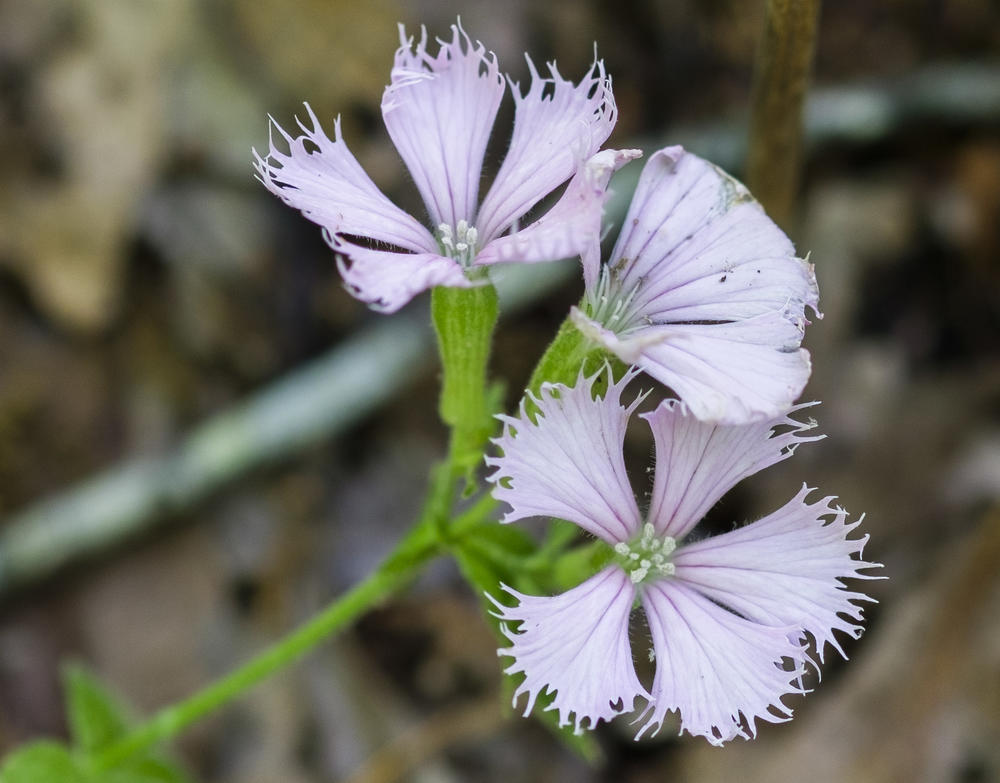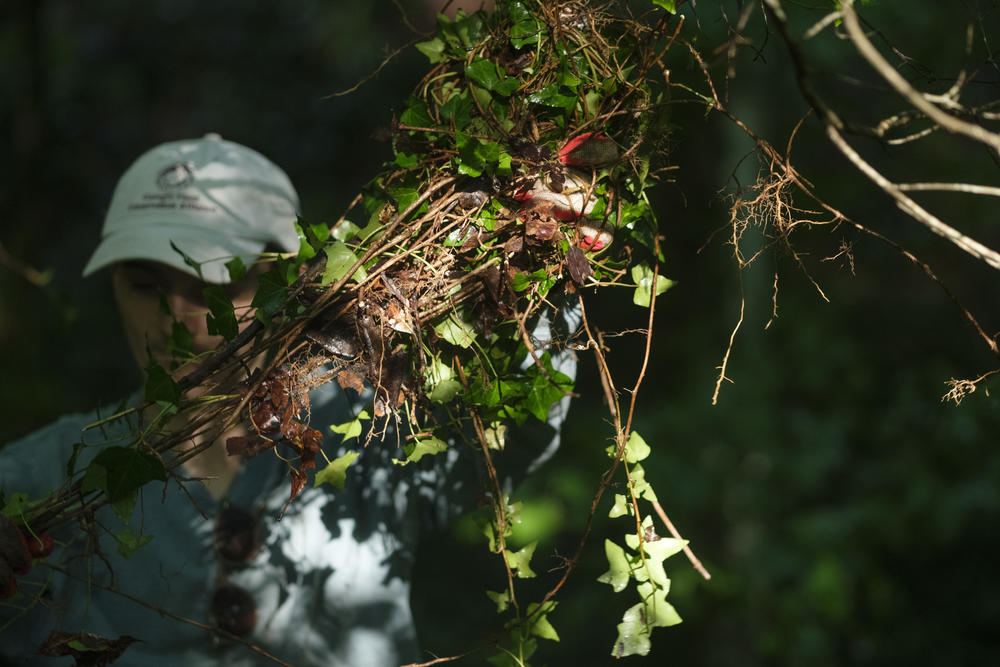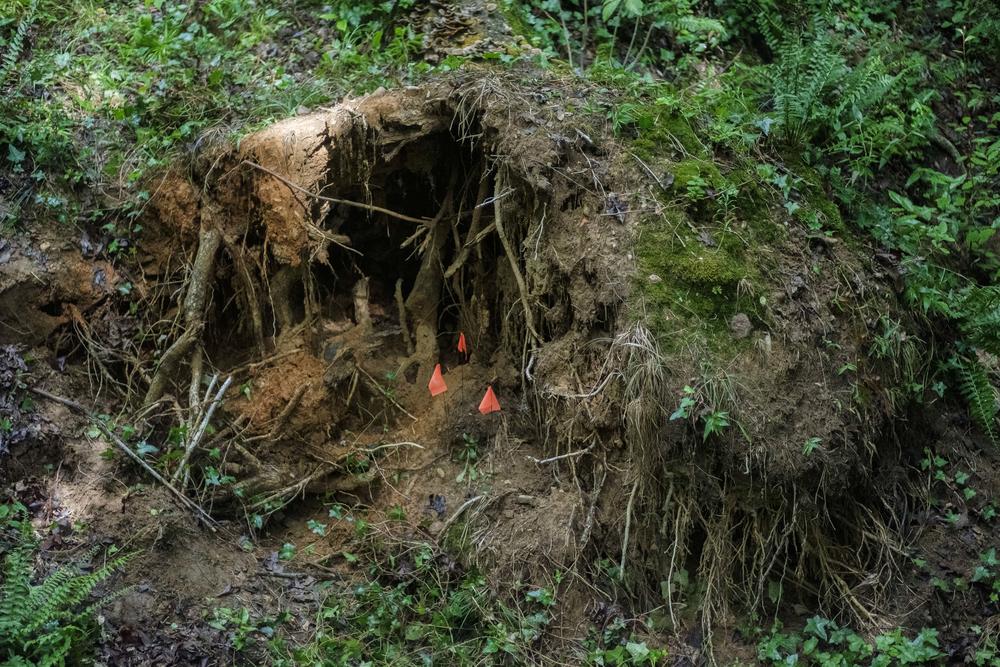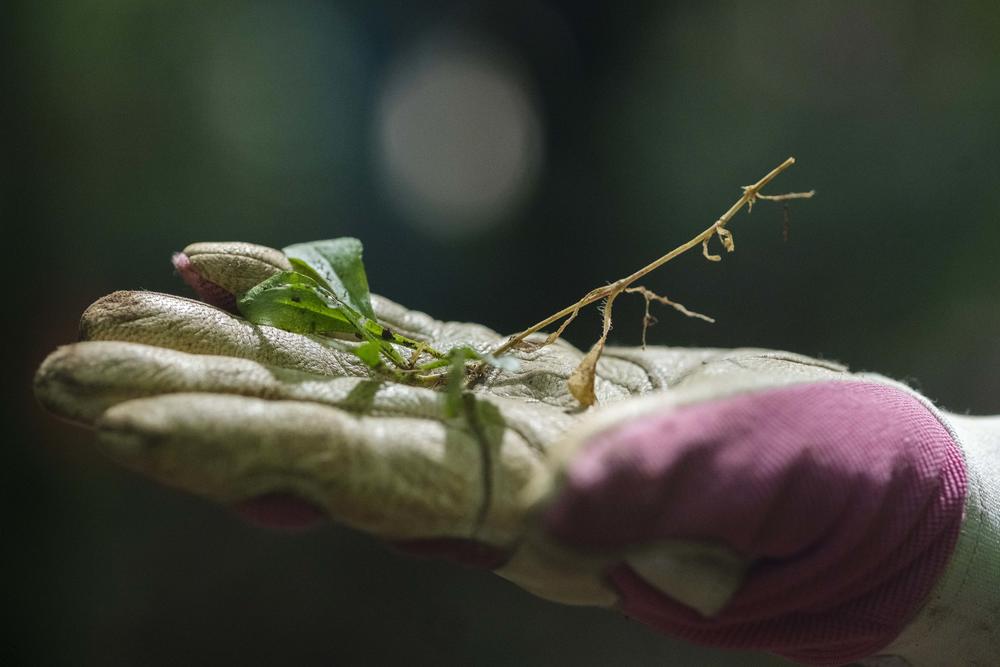
Caption
A fringed campion is seen in bloom in an urban forest in Macon in April 2024. The native flower is federally endangered, only found in a few dozen sites in Georgia and Florida.
Credit: Grant Blankenship/GPB News
|Updated: August 19, 2024 10:54 AM
LISTEN: Because of habitat loss and climate change, rare plants exist in increasingly perilous places. Protecting them means gardening at a landscape scale. GPB's Grant Blankenship reports on one effort to preserve one rare flower in a most unlikely location: urban Macon.

A fringed campion is seen in bloom in an urban forest in Macon in April 2024. The native flower is federally endangered, only found in a few dozen sites in Georgia and Florida.
Very early on a July morning that had yet to heat up, about 15 volunteers spread out in the dappled light cast by the canopy of a forest of widely spaced hardwoods for a day of weeding.
Lots and lots of weeding. All worked by hand with no rakes or shovels.
That’s because Mercer University biologist Heather Bowman Cutway wanted this mixed group of amateur plant enthusiasts and bona fide scientists to preserve the plant she hoped was underneath, the one she taught them to identify on sight before they started working.
“So, it's the little rosettes that are throughout here, these kind of leaves that come out wide,” she said. “Looks like a lot of weeds. If, you know, like, rabbit tobacco, it looks a lot like rabbit tobacco.”
The plant Bowman Cutway described is called the fringed campion. It’s only one of at least 100 rare or endangered plants in Georgia which, today, in the face of climate change and habitat loss, survive largely through the work of volunteer groups like the one which tore into the forest understory with their bare hands.
Today, the fringed campion is Heather Bowman Cutway’s main topic of research, though she never really set out for it to be.
“I started it pretty randomly," she recalled. "I put out a call to a fellow botanist, being like, ‘I need student projects.’ And he was like, ‘How about a federally endangered plant?’”
She said that seemed far more interesting than her other ideas. She’s been hunting for the ground hugging plant with a flower like a frilly pink carnation in remnant tracts of forest squeezed between human development like this one ever since.
“And my research has really shown that these urban places tend to be a really nice reservoir of this plant,” she said.
It's called “urban” because these breathtaking woods — some tulip poplars look to be pushing 4 feet in diameter — are hemmed in on all sides by the city of Macon. It's considered a “reservoir” because fringed campion has, so far, been impossible to grow from seed.
For this plant, conservation means keeping plants alive right here where they are found and cloning them in greenhouses.

A volunteer holds a fistful of ivy, a non-native invasive plant.
Exactly where this spot and others like it are located is kept top secret to protect against poachers.
Luckily, the landowners are excited to work with Bowman Cutway and with Michelle Elmore, lead fringed campion recovery biologist with the U.S. Department of the Interior's Fish and Wildlife Service.
“Across the globe [the plant] only occurs in Georgia and Florida,” Elmore said.
So you’ll find fringed campion here, in the middle of Georgia and on the Apalachicola River on the Florida Panhandle, but that’s it. Elmore said big storms imperil those Florida plants.
“Hurricane Michael really impacted a few populations down there, and we're just not sure about them because we couldn't even get to them,” Elmore said. “A forest like this was completely leveled.”
While climate change means those storms are a larger and more frequent threat to Florida plants, Heather Bowman Cutway said here in Georgia the threats are more manageable.
One is deer, she said. Deer love to crop the flowering tops of the plants and leave the rest.
But the biggest to their survival?
"Really, it’s the invasive plants,” Bowman Cutaway said.

Pin flags mark a single fringed campion plant revealed when English ivy was removed from the shelter of a downed tree’s rootball.
Hence the weeding party, organized for Bowman Cutway by Jennifer Ceska of the Georgia Plant Conservation Alliance and the State Botanical Garden of Georgia at the University of Georgia. Ceska said the invasive plant of top concern on this day was a carpet of English Ivy.
"It's a misplaced plant,” she said.
Ceska said the ivy escaped from homes at the edge of these woods. She said underneath the ivy that escaped from gardens at the edge of these woods were fringed campions, waiting to pop out. For that to happen of course, would take lots and lots of the work which went on around here. Call it landscape curation.
“It is curation. That's a great word,” Ceska said. “We will be managing the lands for forever now.”

A fringed campion rosette and root is seen, bound to be propagated in a controlled setting. Seed stock of the plant is notoriously hard to collect and save, so conservation efforts center on shaping habitat to benefit the plant and growing samples like this as a hedge against habitat loss.
Later, as Ceska predicted, over on the just-weeded bank of a wet weather creek, a fringed campion popped out.
“That one was on top of the stump — What do you call that? Hill? — And then the whole stump hill sloughed off,” she said.
Left on the newly exposed clay was a tiny patch of green in rosette leaves.
“That just made our day!” Ceska enthused.
A cutting of the plant joined others in Heather Bowman Cutway’s growhouse at Mercer University, for safekeeping. And Ceska told the volunteers to stay tuned for another workday here and other sites for other plants that need their help.